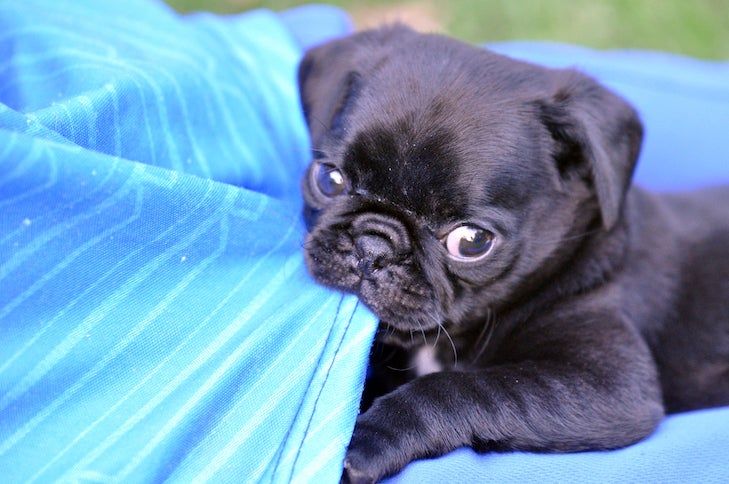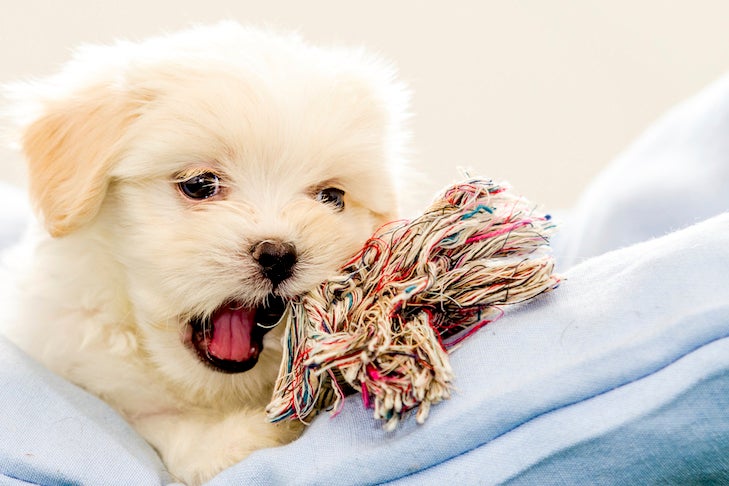
When some dogs are excited, they show their love and attention in challenging ways—treating people like chew toys.
To learn why this behavior happens in the first place and for advice about how to redirect the habit, we turned to the experts: Dr. Jerry Klein, Chief Veterinary Officer of the American Kennel Club, and certified dog trainer Kate Naito, an AKC Canine Good Citizen Evaluator, Manners Program Director at Doggie Academy and the award-winning author of two books about dogs.
The Top 5 Reasons Puppies and Dogs Playfully Nip
According to Naito and Dr. Klein, here are the most common causes of puppies and dogs that nip at their humans.
#1: To share how they’re feeling
As humans, we use our hands to express our emotions—such as through hugging and clapping, explains Naito. “Dogs use their mouths,” she says.
#2: To indicate they want to play
“The bites are not meant to hurt you, but rather to indicate the dog wants a play session, not a cuddle fest,” she adds. This is especially true for puppies and young dogs, who want to do nothing but play most of the day, she says.
You may find this happens when you want to calmly pet your dog. But the mere act of physical interaction can get your pup excited and then expect the teeth to come out.
While biting is an “aggressive behavior,” explains Dr. Klein, “nipping is usually a ‘conversation starter’ in puppies, a vehicle to start play and interaction.”
#3: To explore their environment
Just as human babies explore their worlds with their mouths, so to do puppies, explains Dr. Klein. That’s why when puppies play together, using their mouths is one of their main forms of play, he adds.
#4: It may have to do with genetics
“Certain breeds, such as breeds in the herding group, such as Corgis, Collies, and German Shepherds may have a higher incident due to them being bred to perform their original function for herding calves and sheep using their mouths to nip at the heels of calves and sheep in order to move the herd,” says Dr. Klein.
Naito cautions that it’s important not to make assumptions purely on a dog’s breed. “I get a lot of requests from Retriever or Retriever-mix owners about playful biting,” she says. “While it is true that these dogs are bred to use their mouths, there are other factors at play making them seem extra bitey.”
Families with young kids, for instance, may be more wary of dogs that nip.
“Also, the bigger the dog, the more painful the” playful biting can be, she adds.
More active breeds are also more likely to bite more frequently, says Naito, adding, “So families with large, strong, active breeds should be prepared to do lots of age-appropriate training and exercise for their young dogs.”
#5: They may be teething or want something to chew on
“Teething is terribly uncomfortable,” says Naito, explaining that dogs may simply be looking for anything they can get their paws—or teeth—on to soothe their discomfort. If that’s the case, she recommends having chew toys on hand.

Play Biting vs. Aggressive Biting
You should be able to tell playful nipping from an unfriendly bite because an intentional bite is usually more direct, explains Naito.
When dogs deliver a more serious bite, they usually have specific body language: Approaching from head-on, with their bodies are usually stiff, straight, making no noise, she adds. “If you see a dog focus on a person or animal and suddenly get very still, a bite may follow,” says Naito.
“Biting is an aggressive behavior and requires proper training and professional assistance due to its inherent danger,” notes Dr. Klein.
Since puppies that nip can turn into adults that bite—especially since as adults, they will have larger teeth—the “playful nuisance” of nipping can become dangerous, he says, explaining that’s why people with pets that nip should act early to redirect the behavior.
Do’s and Don’ts for Training Dogs That Nip
Naito and Dr. Klein offer the following do’s and don’ts for getting dogs into good habits and strategies for curbing the behavior when your dog does start to nip.
Do offer your puppy:
- Scheduled playtime and activity time to minimize boredom
- Plenty of rest and time out periods after plenty of stimulation
- Chew toys: Dr. Klein recommends having a few out at a time and swapping them out on a weekly basis to keep dogs interested
- Food puzzles, which great for mental and physical stimulation
- Edible treats when teething
- A more appropriate alternative whenever the nipping instinct kicks in
- Tug time to teach dogs the rules for “polite play,” says Naito. Make sure your dog sits before your start and the game only continues for as long as the toy is the only thing your dog chews. “If he redirects to your hand, the game stops and you remove the toy until he can sit or stand to resume the game,” she explains.
Don’t:
- Overstimulate your puppy with wild play
- Unintentionally reward him when he nips
- Hold your dog’s muzzle shut as a correction, which teaches fear
To intervene when your dog is play biting, make sure not to come across “like a giant squeaky toy” says Naito, something young kids often appear like. That means not appearing too exciting, keeping your body quiet, and presenting appropriate chew toy alternatives.
“The longer the toy, the less likely your dog is to accidentally bite your hand at the other end of it,” she says.
The second your dog’s teeth touch your skin or clothes, be prepared to put your dog in a “time out.” “These early ground rules set your dog up for success and teach him that only polite behavior will get him what he wants,” she says.
Ultimately, the goal of training should be to teach your dog that polite forms of play are more fun than biting behaviors, notes Naito.
Keep in mind, it may take weeks or months before you see signs of improvements.
“Since dogs are teething until roughly seven months old, and some dogs have puppy-like play energy well into their second year, it can be a long road,” notes Naito. “As long as you can stay consistent with encouraging polite play, you’re likely to see a slow (but not always steady) progress through adolescence.”
The good news for those who intervene early, the sooner you address the problem, the faster you should expect to see results, says Dr. Klein.
“Play biting is a common part of puppyhood,” says Dr. Klein, something most will outgrow, particularly early and consistent training.
Need help with your adorable new puppy? Training your dog can be challenging without expert help. That’s why we’re here to help you virtually, through AKC GoodDog! Helpline. This live telephone service connects you with a professional trainer who will offer unlimited, individualized advice on everything from house-training to behavioral issues.

